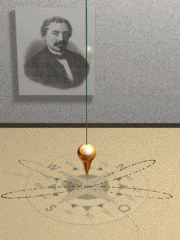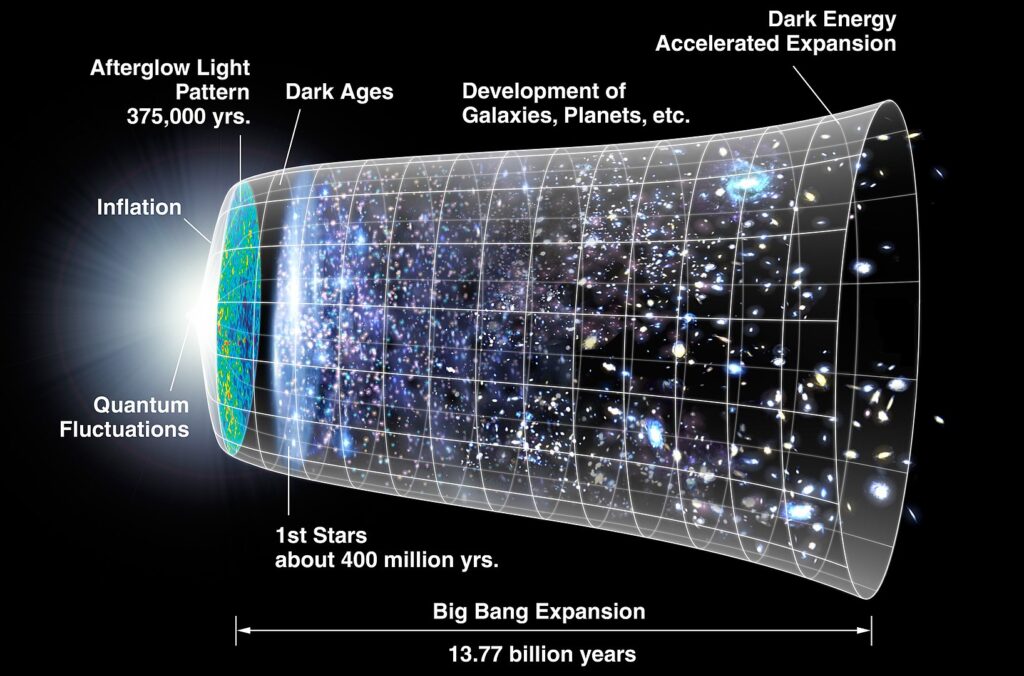
What would it mean if quantum clocks could operate with the same mathematical rules 7 minutes into the future and 7 minutes into the past? Image by Gerd Altmann, of Pixabay
By James Myers
Time flows one way only, from past to future – isn’t that obvious?
The intuitive view that time’s arrow goes in only one direction is now being challenged, with new evidence from the quantum realm of subatomic particles pointing to not one but two arrows of time. If time does in fact flow backward as well as forward at the smallest scale of the universe, the implications for physics, cosmology, and quantum computing could be significant.
Researchers at the University of Surrey have developed mathematical evidence that time, at least at the quantum level, could theoretically operate in two directions without requiring a change to physical equations. Their paper was published in January in Science Reports.

Dr. Andrea Rocco. Image: University of Surrey
The researchers began with a quantum system that interacts with its environment (called an “open system”) and then isolated the system to examine its mathematical properties alone. Their calculations assumed that the surrounding environment, extending universally, is so large that energy leaving the system would dissipate and never return.
Associate Professor in Physics and Mathematical Biology Dr. Andrea Rocco, who co-authored the paper, explains that two arrows of quantum time would not mean that we would see something as unbelievable as spilled milk putting itself back in the glass. The time that we experience at the macro level is asymmetric, which is why we have memories of the past and not the future.
Comparing time at the quantum level to a pendulum, however, Dr. Rocco stated that the motion of the pendulum looks “just as believable in reverse. The puzzle is that, at the most fundamental level, the laws of physics resemble the pendulum; they do not account for irreversible processes. Our findings suggest that while our common experience tells us that time only moves one way, we are just unaware that the opposite direction would have been equally possible.”
We experience time as a straight-line from past to future, but If quantum time is like a pendulum, it would mean that, fundamentally, time operates equally in the past and future. Time would work both in curves that are symmetric, and in straight lines that are asymmetric. At some points, our one physical “arrow” of time and the “circle” of quantum time might be interchangeable.
Although the mathematics of time reversibility were derived for open quantum systems, closed systems that are not influenced by the external environment are still inherently connected to open systems. Any system is subject to the constant rotation of everything in the universe, and phenomena like the Brownian motion of particles suspended in a fluid medium show that the fundamental components of matter can exist in an inherently variable state.

“The Foucault pendulum of 1851 was the first demonstration of the Earth’s rotation that did not involve celestial observations, and it created a ‘pendulum mania’. In this animation the rate of precession is greatly exaggerated.” Image and caption: Wikipedia
Variability, which results in change whether microscopic or visible, breaks the symmetry of time by creating irreversible effects.
The problem is that closed quantum systems should be incapable of any change whatsoever, and the researchers resolved the problem of asymmetry in a closed system by incorporating not one but two opposing arrows of time in their analysis.
Scientific American writer Gayoung Lee suggests imagining two arrows of time by picturing a cup of water balanced precariously on a knife’s edge. The cup could fall either of two ways, to one side of the edge or the other, but the result of tipping in either direction would be the same. Either to the right or left of the knife’s edge, the mathematics describing the dissipating motion of the spilling water would be identical– as if a left arrow of time operates exactly like a right arrow of time, differing only in direction but not in effect.
Lee quotes Dr. Rocco: “In a sense, we are stuck in this universe in which time actually goes in one direction. But the equations of motion that we are considering would have allowed the universe to go in the other direction.” Rocco explained that the mathematics preserve the symmetry of time in either direction, and imply that we could no longer say that “defining an arrow of time” is imposed by the external environment. In open and closed quantum systems with two arrows of time, each arrow would be capable of imposing a change.
A quantum of energy is defined as the least amount of energy in the universe that can either cause change or be changed and so, being capable of both cause and effect, a quantum would seem to require, at all times, two arrows for action whenever it entangles, or connects, with another quantum. The consequences and mathematics of two arrows of time could, in this sense, be particularly helpful to advance stable quantum circuitry.
The implications for quantum computing and cosmology are potentially significant.
The development of fully-functioning quantum computers, capable of far greater speed and accuracy than the most advanced supercomputers now in use, has been held back by the problem of fragile quantum circuits disconnecting when disrupted by the external environment. The problem is called decoherence, and working with two arrows of time instead of one might provide a significant boost for already impressive strides toward resolution.
Decoherence of quantum circuits can be likened to the dissipation of water spilling to the left or right of a knife’s edge. Whether it’s the flow of information spilling from a broken circuit or the splashing of water out of a falling cup, there is a widespread distribution of something that had previously been contained. The mathematics of a two-arrow time flow could describe both the original and end state of a dissipation.
As physicist and Quantum Steampunk Laboratory leader Nicole Yunger Halpern explained to Scientific American, dissipative processes like quantum circuit disconnections and water spills are considered asymmetric with regard to time because the initial configuration ends up irrelevant to the final state of affairs. Yunger Halpern points out, however, that this interpretation depends on an assumption of one arrow of time. Assuming only one arrow allows us to recognize time asymmetry: for example, if we were to watch two movies – the first with water spilling out of a cup and the second with water flowing back into the cup with no apparent cause – we would think the reason for the asymmetry of the second movie was that it was the first film run in reverse.
Being able to track and record the progression of information flows from quantum to quantum inside a quantum computer, even when circuit breaks result in dissipation, is a key hurdle that when overcome could unleash the machine’s power and potential. Could changing the assumption that time has only one arrow unlock a mathematical solution to the problem of decoherence?

Illustration of the expansion of the universe, from the Big Bang to present. The thermodynamic release of energy from the Big Bang continues to dissipate in space and time, in various forms of physical matter. Image: NASA/WMAP Science Team, on Wikipedia.
Noting that it is fascinating to speculate on the consequences of a changed definition of time’s arrows, the study’s co-authors state that “the natural assumption that the universe was dissipative from time zero onwards” could imply that opposite arrows of time appeared at the instant of the Big Bang, when the physical universe was born. This, they write, “would account in turn for the maintenance of time-reversal symmetry despite the ensuing dissipative nature of the universe. We would happen to live in one of them, where dissipation and entropy increase are common experience, but unaware of the existence of the other alternative possibility.”
While the nature of time itself remains elusive, physical time can operate in one dimension only.
What would it mean for there to be another, underlying, dimension of time at the universe’s tiniest scale of the quantum?
It’s an axiom that humans make mistakes, and it’s hard to imagine anyone who hasn’t at least once in their life wished that they could turn back the hands of time for a do-over. While the feat of reversing time isn’t possible in the three physical dimensions that our bodies occupy, mathematics show that in theory time could be reversible at the microscopic level of a quantum system.
If time has two arrows, our bodies and everything else physical appear to operatein only one of them – the arrow that moves in a single direction and where the second law of thermodynamics ensures that physical things can only go from a state of order (like the milk in the glass) to a state of disorder (like the spilled milk on the floor), and not the other way around.
Being limited to one arrow of time is a good thing for us. That’s because sequencing events in time from beginning (like the milk in the glass) to end (like the milk on the floor) – which is to say knowing the sequences of causes and effects of events in time – is the only logical way for our minds to derive sense and meaning from time.
However, if the very tiniest scale of time at the sub-atomic quantum level is reversible, and oscillates like a pendulum with two arrows between past and future, what would time’s round trip do to any physical matter – including our bodies and everything we see around us?
It’s hard to imagine, because our daily experience is rooted in a single arrow of time. But maybe imagination itself is a feature and necessity of time’s two-arrow reversibility.
Imagination is predicated on its capacity for mental time-travel, to revisit past events and project different outcomes had we adjusted our actions, even when our bodies are stuck in the present and have no way of undoing what we’ve done. Although it can’t move our bodies, mental time travel gives us another type of powerful motion: the motion, in the single moment of the present that’s common to us all, of changing our actions with lessons learned from human events of the past.
Until the definition of the second is changed, however, caesium clocks will likely remain the best way of keeping time and fountain clocks will, at least for the time being, provide the most precise measure of the frequency of caesium atoms.
Craving more information? Check out these recommended TQR articles:
- How Many Languages Are There? Scientists Shed Light on What Animals Other Than Humans are Saying
- Wild Mathematics: Scientific Evidence of the Numerical Abilities of Animals
- Scientists Call for Halt to Creation of Mirror Bacteria, Warning of Global Risk to Life
- Time, the Sun, and Life: Even Bacteria Know When Earth Makes a Seasonal Change
- James Webb Space Telescope: Stunning Images Deliver New Insights on the Big Bang and Early Universe




